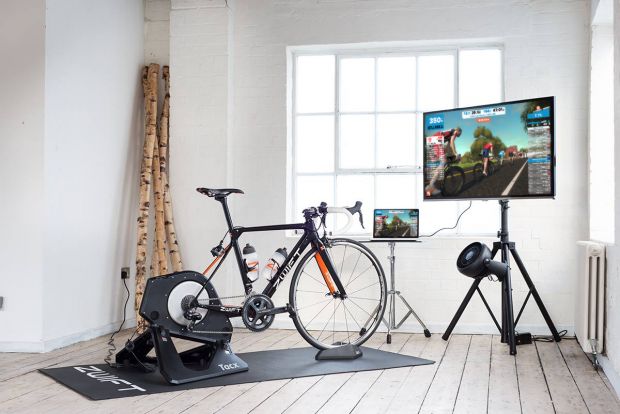Zwift Made Indoor Cycling Fun, And Now They’re Targeting Treadmills
You’ll soon be able to join friends and run in a virtual world

When the weather outside turns frightful, indoor training becomes a very appealing option for runners and cyclists – but the trade-off between escaping the worst of the elements and dealing with the boredom of long, solo sessions on treadmills and turbo trainers is still a tricky one.
Cyclists, on the other hand, have been able to reduce the boredom of indoor training for some time now thanks to Zwift, an interactive game that plays host to thousands of riders every day.
Zwift links with a sensor that lets players control an onscreen avatar with their pedalling – the faster they go in real life, the faster their avatar moves on screen – but the real fun is in joining the many group rides and races available each day.
This kind of gamification is the perfect antidote to the boredom of whirring the pedals alone. It’s a new way to make your exercise social, as Zwift CEO Eric Min explains: “It’s not gadgets and apps that motivate people to be fit or be active, it’s other people. What we’ve done is just bring other people into a virtual space.”
And now runners will be able to get the benefits of Zwift when they’re forced off the streets and onto treadmills. You can already use Zwift for running via an Easter egg released in an app update in November (and hundreds already do), but a more formal release is expected in early spring.
The set-up for cyclists on Zwift can be fairly complicated. You need a bike, a compatible indoor trainer and a Bluetooth power/cadence sensor. Plus the Zwift subscription, which is $10 (about £8) a month, and a screen to watch your avatar on (or an iOS device with the app, which isn’t currently available on Android).

It all adds up to something that’s designed for pretty serious riders, but it should be more accessible for runners.
Get the Coach Newsletter
Sign up for workout ideas, training advice, reviews of the latest gear and more.
“It’s actually easier to run on Zwift than it is to cycle,” says Min, who had just completed a Zwift run before speaking to Coach.
“I used an iPhone, Apple Watch and footpod. I think we can get it down to your iPhone and Apple Watch, or iPhone and sensor. That would work on any treadmill. Eventually we’ll migrate to treadmills that will connect directly to Zwift.”
A Bluetooth footpod like the Polar Stride Sensor will still set you back £60 and you’ll obviously also need access to a treadmill and the Zwift subscription. But if it opens up a new world of virtual running to make treadmill session more palatable, that’s something many runners will be happy to accept. Running with companions, even virtual ones, makes the distance fly by.
“I guarantee that every 15 minutes there will be a 5K or 10K run with a couple of hundred people lining up to run together virtually,” says Min. “It’s happening already with cycling.”
“[Imagine] runners from all over the world going out for their 5K. I think there was a virtual Parkrun this past weekend on Zwift – maybe the weather was foul or something! There was maybe 30 or 40 runners that did it together.”
The other advantage for more serious runners could be accessing coaching, something that’s already happening with cyclists on Zwift.
“There’s nothing stopping a coach talking live to the runners as they're doing their session – a group run with an instructor who may or may not be running,” Min says. “It opens up a whole new way of training with others from the comfort of your home or the gym.”
For more info on Zwift and a free seven-day trial subscription, visit zwift.com

Nick Harris-Fry is a journalist who has been covering health and fitness since 2015. Nick is an avid runner, covering 70-110km a week, which gives him ample opportunity to test a wide range of running shoes and running gear. He is also the chief tester for fitness trackers and running watches, treadmills and exercise bikes, and workout headphones.
